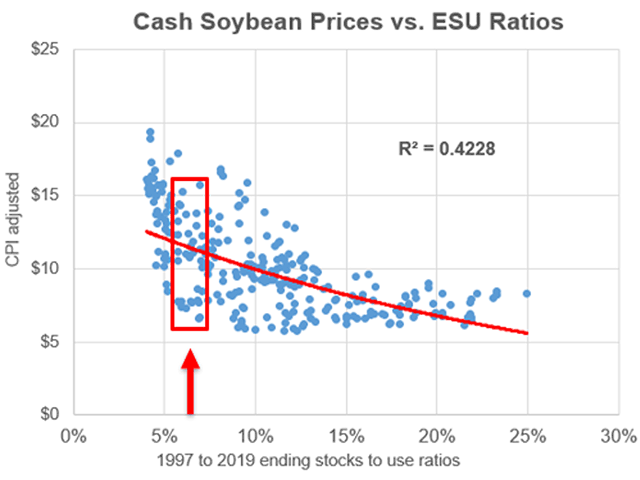Todd's Take
Is the US Out of Soybeans?
On Thursday, Nov. 5, DTN's index of cash soybean prices closed at $10.53 per bushel, the highest in over four years. It is a remarkable achievement in the year of COVID-19, and we can't say prices are done going up yet. U.S. soybean export commitments have already reached 81% of USDA's export estimate for 2020-21 and China's domestic soybean price remains high, seen at $15.88 per bushel Thursday for the January contract on the Dalian exchange.
Given the active pace of exports in the U.S., USDA's ending stocks estimate is probably too high and there is a legitimate threat soybean stocks could get even tighter -- an extremely bullish possibility for soybean prices, which was unthinkable earlier this year.
Earlier this summer, China emptied the cupboards of the world's largest soybean producer. USDA estimates Brazil will have only 82 million bushels (mb) on hand when the current season ends Jan. 31, 2021. The estimate is backed up by an FOB soybean price in Brazil for December that is at its highest level in six years and $1.45 per bushel above the comparable price at the U.S. Gulf. There is a lot of pressure on Brazil to come up with another record soybean crop this year, but that may be difficult with La Nina influencing drier weather in southern Brazil and Argentina.
Because China doesn't willingly share grain supply information the way USDA shares information about the U.S., we don't have a good way of estimating just how big China's soybean needs are. I know USDA and many private firms go to a lot of effort trying to estimate China's import needs, but there is a lot of hearsay and guessing involved. China watchers didn't see the current surge in soybean demand coming earlier this year and they don't know when it's going to end now. It is better to admit the things we don't know and look to the market for clues.
P[L1] D[0x0] M[300x250] OOP[F] ADUNIT[] T[]
The uncertainty of South America's weather is the next potentially bullish layer on top of a situation that is already full of bullish potential. The seven-day forecasts for southern Brazil and Argentina expect only light rain amounts, in line with the typical expectations for La Nina conditions.
Based on USDA's October ending soybean stocks-to-use ratio of 6.4%, a look at DTN's national index of cash soybean prices over the past 23 years, adjusted for inflation, shows a statistical expectation of $11 per bushel. Given the high level of export commitments on the books, USDA will probably lower its estimate of ending soybean stocks in Tuesday's World Agricultural Supply and Demand Estimates report (WASDE) report on Nov. 10, an even more bullish scenario for prices.
A price of $11 per bushel may sound like a reasonable estimate for the current situation, but I need to mention that, when soybean supplies get as tight as they are becoming, the correlation to actual prices is very loose and actual price possibilities are highly volatile. Similar scenarios during the past 23 years show prices ranged between roughly $7 a bushel and $15 per bushel. As I've often said, markets are human and humans are emotional; markets tend to get even more emotional when supplies are tight.
Offering two examples, there was a time in May 2008 when the cash inflation-adjusted soybean price hit $15.24 per bushel on a 6.0% ending stocks-to-use ratio. Another time in August 2005, the inflation-adjusted soybean price traded as low as $7.31 per bushel, while USDA estimated a 6.2% ending stocks-to-use ratio.
If the two examples were outliers, we could ignore them, but the data shows several such occurrences, offering a wide spread of possibilities for similar supply situations.
In the college textbook, tighter supplies lead to higher prices. In the real world, tighter supplies make higher prices more likely, but they also increase the range of price possibilities. In other words, tight supplies make the soybean market a riskier place.
I don't say this to scare but to help producers have a sober awareness of the price risk in this tight supply situation. China took the soybeans out of Brazil and they may be about to do the same here in the U.S. (we can't confidently say). Certainly, South America's weather will play a big role during the next several months.
Neither economic theory nor past prices can predict the future, but they can remind us that surprises are still possible, even when things look extremely bullish.
Todd Hultman can be reached at Todd.Hultman@dtn.com
Follow him on Twitter @ToddHultman
(c) Copyright 2020 DTN, LLC. All rights reserved.




